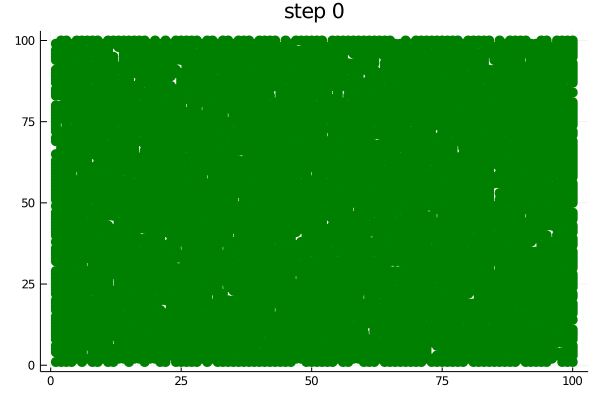Forest fire model

The forest fire model is defined as a cellular automaton on a grid. A cell can be empty, occupied by a tree, or burning. The model of Drossel and Schwabl (1992) is defined by four rules which are executed simultaneously:
- A burning cell turns into an empty cell
- A tree will burn if at least one neighbor is burning
- A tree ignites with probability
feven if no neighbor is burning - An empty space fills with a tree with probability
p
The forest has an innate density d, which is the proportion of trees initialized as green. This model is an example that does not have an agent_step! function. It only uses a model_step!. It is also available from the Models module as Models.forest_fire.
Defining the core structures
We start by defining the agent type
using Agents, Random, AgentsPlots
mutable struct Tree <: AbstractAgent
id::Int
pos::Tuple{Int,Int}
status::Bool # true is green and false is burning
endThe agent type Tree has three fields: id and pos, which have to be there for any agent, and a status field that we introduce for this specific model. The status field will hold true for a green tree and false for a burning one. All other model parameters go into the AgentBasedModel.
We then make a setup function that initializes the model.
function model_initiation(; f = 0.02, d = 0.8, p = 0.01, griddims = (100, 100), seed = 111)
Random.seed!(seed)
space = GridSpace(griddims, moore = true)
properties = Dict(:f => f, :d => d, :p => p)
forest = AgentBasedModel(Tree, space; properties = properties)
# create and add trees to each node with probability d,
# which determines the density of the forest
for node in nodes(forest)
if rand() ≤ forest.d
add_agent!(node, forest, true)
end
end
return forest
end
forest = model_initiation(f = 0.05, d = 0.8, p = 0.05, griddims = (20, 20), seed = 2)AgentBasedModel with 327 agents of type Tree space: GridSpace with 400 nodes and 1482 edges scheduler: fastest properties: Dict(:f => 0.05,:p => 0.05,:d => 0.8)
Defining the step!
Because of the way the forest fire model is defined, we only need a stepping function for the model
function forest_step!(forest)
for node in nodes(forest, by = :random)
nc = get_node_contents(node, forest)
# the cell is empty, maybe a tree grows here
if length(nc) == 0
rand() ≤ forest.p && add_agent!(node, forest, true)
else
tree = forest[nc[1]] # by definition only 1 agent per node
if tree.status == false # if it is has been burning, remove it.
kill_agent!(tree, forest)
else
if rand() ≤ forest.f # the tree ignites spontaneously
tree.status = false
else # if any neighbor is on fire, set this tree on fire too
for cell in node_neighbors(node, forest)
neighbors = get_node_contents(cell, forest)
length(neighbors) == 0 && continue
if any(n -> !forest.agents[n].status, neighbors)
tree.status = false
break
end
end
end
end
end
end
endas we discussed, there is no agent_step! function here, so we will just use dummystep.
Running the model
step!(forest, dummystep, forest_step!, 1)
forestAgentBasedModel with 330 agents of type Tree space: GridSpace with 400 nodes and 1482 edges scheduler: fastest properties: Dict(:f => 0.05,:p => 0.05,:d => 0.8)
step!(forest, dummystep, forest_step!, 10)
forestAgentBasedModel with 94 agents of type Tree space: GridSpace with 400 nodes and 1482 edges scheduler: fastest properties: Dict(:f => 0.05,:p => 0.05,:d => 0.8)
Now we can do some data collection as well using an aggregate function percentage:
forest = model_initiation(griddims = (20, 20), seed = 2)
percentage(x) = count(x) / nv(forest)
adata = [(:status, percentage)]
data, _ = run!(forest, dummystep, forest_step!, 10; adata = adata)
data11 rows × 2 columns
| step | percentage_status | |
|---|---|---|
| Int64 | Float64 | |
| 1 | 0 | 0.8175 |
| 2 | 1 | 0.675 |
| 3 | 2 | 0.35 |
| 4 | 3 | 0.08 |
| 5 | 4 | 0.035 |
| 6 | 5 | 0.03 |
| 7 | 6 | 0.0375 |
| 8 | 7 | 0.045 |
| 9 | 8 | 0.06 |
| 10 | 9 | 0.065 |
| 11 | 10 | 0.07 |
Now let's plot the model using green and red color for alive/burning
forest = model_initiation()
step!(forest, dummystep, forest_step!, 1)
treecolor(a) = a.status == 1 ? :green : :red
plotabm(forest; ac = treecolor, ms = 6, msw = 0)or animate it
forest = model_initiation(f = 0.005)
anim = @animate for i in 0:20
i > 0 && step!(forest, dummystep, forest_step!, 1)
p1 = plotabm(forest; ac = treecolor, ms = 6, msw = 0)
title!(p1, "step $(i)")
end
gif(anim, "forest.gif", fps = 2)